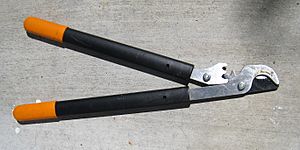Loppers facts for kids
Loppers are a special kind of cutting tool with long handles. Think of them like giant, super-strong scissors for your garden! They have two long handles, and at the end, there's a sharp blade that cuts against a flat, blunt surface. Because they have two parts that work together, we always talk about them as a "pair of loppers," just like a "pair of scissors."
Loppers are perfect for cutting thick plants, small branches, or even young trees (called saplings). They can cut things up to about an inch (2.5 cm) thick, which is roughly the size of your thumb.
What Are Loppers Used For?
Loppers are very useful in many outdoor activities. They are often used in:
- Gardening: To trim bushes, shrubs, and small trees.
- Tree Care: To remove dead or unwanted branches from young trees.
- Prairie Restoration: To help clear out unwanted plants and keep natural areas healthy.
Loppers vs. Other Tools
Loppers fill an important gap between smaller cutting tools and larger ones.
- Gardening Clippers or Pruners: These are small, one-handed tools used for thin stems and flowers. Loppers can cut things that are too thick for these smaller tools.
- Saws: If a branch or tree is too big for loppers (thicker than an inch or so), then you'll need a saw to cut it safely. Loppers are not meant for very thick wood.
How Do Loppers Work?
The long handles of loppers give you extra power, also known as leverage. When you squeeze the handles, the force you apply is multiplied, making it easier to cut through thicker branches than you could with just hand pruners. This leverage helps you make clean cuts without too much effort.
There are two main types of loppers:
- Bypass Loppers: These have a blade that "bypasses" or slides past a curved hook, much like scissors. They make very clean cuts and are best for live branches, as they cause less damage to the plant.
- Anvil Loppers: These have a straight blade that cuts down onto a flat, anvil-like surface. They are often used for cutting dead or dry wood, which can be tougher.
Using the right tool for the job helps keep plants healthy and makes your work easier and safer!
Images for kids


